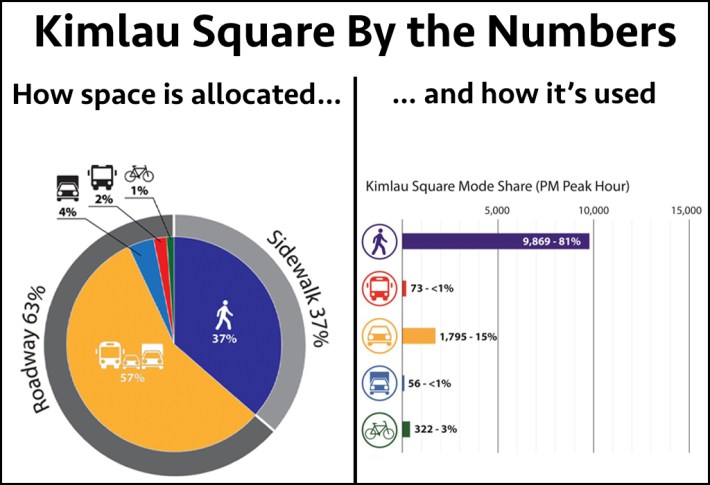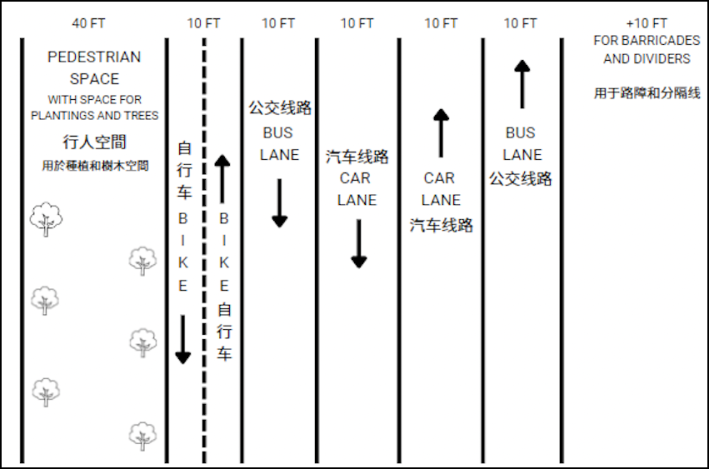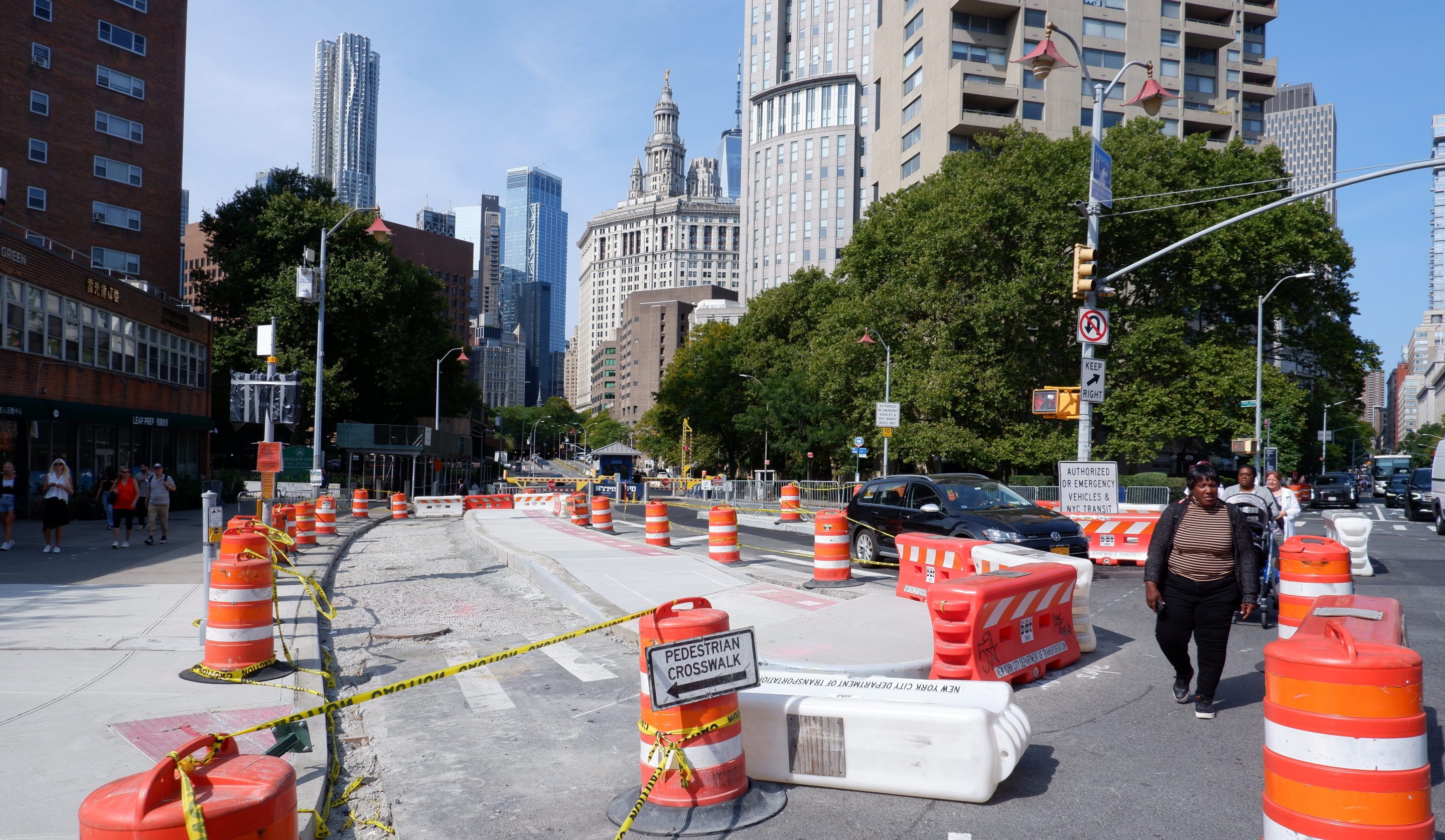Chinatown residents who want to bring a flood of cars back to Park Row gained support from Washington, D.C., as Rep. Dan Goldman recently said he would like to see drivers back on the Lower Manhattan strip that's largely been an NYPD security zone since 9/11.
The federal lawmaker recently told a handful of local news outlets at a low-key meeting that a majority of the Chinatown community wants Park Row to revert to private automobile traffic, saying he knows the situation from his years working at the nearby courthouses as an Assistant United States Attorney.
Park Row is currently littered with security infrastructure and parking for NYPD and officials of the nearby court houses, but is also one of the rare streets downtown where pedestrians, cyclists, and buses have priority without having to contend with the dangerous and productivity-draining traffic that clogs adjacent thoroughfares. But that wasn't on Goldman's mind.
"I personally think that it does make sense to open it to some vehicular traffic, but I have not to this point said that because my personal opinion is not nearly as important as the community’s opinion," Goldman told Sing Tao Daily during the meeting at his Lower Manhattan office last week, according to a recording obtained by Streetsblog. "It certainly seems that the significant majority of the community wants Park Row to reopen [sic] and what we now need to figure out is first a commitment from the city to reopen it in conjunction with the security concerns and any other issues that need to be taken into account."
The lawmaker, one of the richest members of Congress, held the limited Q&A last week with Chinese-language media, but the event was not on his public schedule nor did his team post it on his social media accounts. Goldman's office did not respond to multiple requests for comment from Streetsblog.
The pol is one of several local electeds pushing for the removal of the checkpoint-style barricade on Park Row; Council Member Chris Marte has been lobbying city officials to bring back cars since his election three years ago, citing local civic groups who say traffic restriction has hurt Chinatown businesses.
However, the vast majority of people passing through the bustling area do so on foot, according to new Department of Transportation data, and some locals urged their representatives to not heed the calls for more cars in one of the densest urban neighborhoods in the country.
"[The area] is heavily congested in all way shape or form, and I’m just kind of alarmed that this might be pushed through purely based on sentiment as opposed to based on review and design process," said Jason Lee, an architecture professor who lives in Chatham Towers right next to Park Row.
Instead, the city should lean into a better pedestrian connector and remove the current law enforcement takeover of the space — without ceding ground back to cars.
"If you limit traffic and you reorganize, and you make it a much stronger pedestrian-oriented connection, … it would make a huge difference for residents and visitors," Lee said.
Last year, Mayor Adams nearly restored car access to Park Row for the first time in almost a quarter-century at the request of local electeds, but backed off after other residents pushed back.
The roughly one-third-mile corridor closed to traffic after the Sept. 11 terror attacks, and the strip has remained exclusive to law enforcement, buses, pedestrians, cyclists, and resident drivers due to safety concerns raised by the NYPD, whose main headquarters are adjacent to Park Row.
The cops along with court officials from the adjacent state and federal court houses have since turned the area into a battle zone, littered with barricades and parking for their agency and private vehicles, frustrating residents who say it turns the area into NYPD's private campus.
Adams earlier this year announced a $56-million overhaul of Park Row and the convoluted adjacent intersection of Kimlau Square, and DOT has started a small-scale street improvement project to remove some of the many police barriers and upgrade existing bike, transit, and pedestrian infrastructure, ahead of a potentially larger redesign.

Goldman criticized the agency for building out some of those upgrades, like an off-set concrete boarding island for a bus stop near Worth Street, which proponents of car traffic worry will cement the closure of Park Row.
"I have been assured that the bus island and any other temporary stopgap measures will not prevent Park Row from reopening [to cars], but it doesn’t make sense to spend that amount of money for something that I think is of marginal value, and that will be an obstacle to Park Row reopening," Goldman said during the small press confab last week.
DOT officials have said they want to complete a traffic analysis before deciding whether to open Park Row to cars.
More than eight in 10 people moving through the area around Kimlau Square are pedestrians, and the number of people on foot is largest near Park Row, but people only get a little over a third of the streetscape, according to early data from the review.
Marte recently rallied residents around reopening Park Row to cars, saying those opposing it were in the minority.
"We have to show the mayor that the majority ... the people that live and work in this community want Park Row open," the city pol said at a July town hall hosted by the Chinese Consolidated Benevolent Association. "We want to show the city that if they want our support when they run for election, if they want our donation as a community when they run for reelection, they have to listen to us."
Marte said he took the hyper-local issue all the way to Senate Majority Leader Chuck Schumer in 2021, who he claimed was also on board with reopening the road to cars.
"I told him we finally need to open up Park Row and he said, ‘Yes, I support that as well,'" Marte told the crowd at the July meeting.
A spokesperson for Schumer, Angelo Roefaro, confirmed that the two pols discussed the issue, but said the top Democrat will "follow the consensus of the community."
Marte showed off and distributed a proposal for Park Row with four lanes for vehicles [PDF], including two for private cars and two for buses, along with space for cyclists and pedestrians.

"We can have an approach that is 'yes' for everyone, that's a win-win solution, and that doesn't pit cyclists against pedestrians, to bus riders, and to people driving in their cars," the lawmaker told the audience nearly two months ago.
The road currently has only one travel lane each way, a bike path, along with space where police cars park, but it narrows closer to the Brooklyn Bridge, squeezing together pedestrians and cyclists in one tight section, so it's unclear whether those four lanes of traffic would fit all the way through.
The diagram was based on the average width of the road, according to Marte's spokesperson Caitlin Kelmar, who emphasized it "wasn’t a formal proposal, just a sketch to demonstrate how large Park Row is."
Lee, the Chatham Towers resident, said that much of the push comes from locals fed up with the NYPD taking over the area for two decades-plus, but he said the street should cater more to pedestrians, not less — for example by making Park Row a welcoming connector for the throngs of tourists on the Brooklyn Bridge.
"Yes I think there should be more enforcement on how NYPD occupies Park Row… but that is a separate issue than the traffic pattern that reopening Park Row to private vehicles would cause," he said.
Other people had mixed feelings about the road's future, with one passerby saying she appreciated the extra space for pedestrians, but hoped that reopening Park Row would "help the flow" of cars in the area.
"I do like the feeling of being able to walk across without having to worry about traffic," said Virginia Won. "[But opening it to cars] will help the flow of traffic."
One man jogging down the largely car-free road said the city should cater to people, not motor vehicles.
"We need to keep it open for people. I don’t see the need to open it for cars," said Mike Kurylo. "Don’t cater to people coming in from Long Island in their cars."
City officials declined to say whether they plan to reopen Park Row to cars, with a City Hall spokesperson noting that they are still reviewing security concerns.
"The safety of New Yorkers and visitors alike is our top priority, and we constantly review security measures in place on Park Row based on perceived threats and other considerations," said Liz Garcia in a statement.






